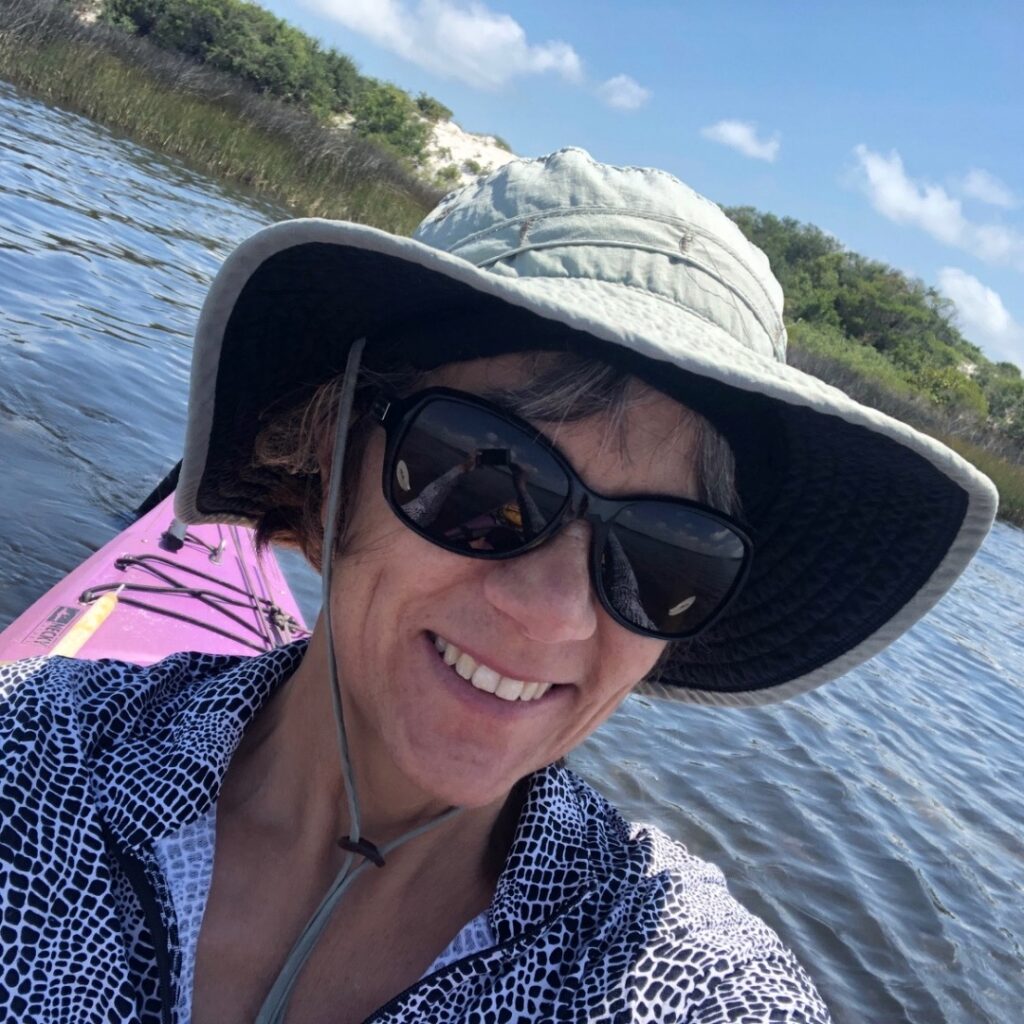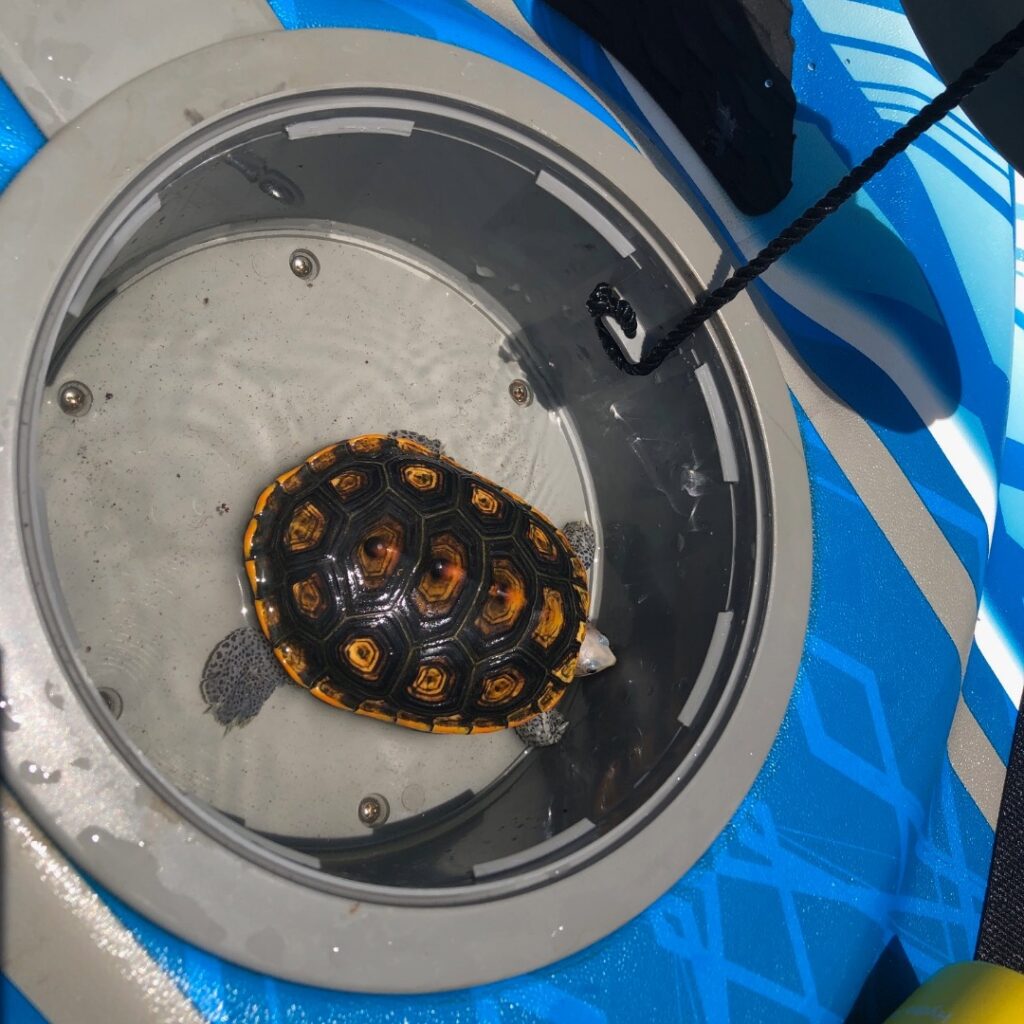April marks Participatory Science Month, also known as Citizen Science Month. Florida Sea Grant proudly celebrates the contributions of individual volunteers in coastal and marine research. Whether seasoned participants or newcomers, their efforts in monitoring coastal habitats or tracking wildlife have a profound impact on research and conservation efforts statewide.

Okaloosa resident and Panhandle Terrapin Project county coordinator, Mathilda Ravine. Image courtesy of Mathilda Ravine.
Mathilda Ravine’s early years were filled with adventures along the Emerald shores of the intercoastal waterway between the Choctawhatchee Basin and Escambia Bay watersheds. Despite spending summers swimming, splashing around, and catching crabs since fifth grade, she remained unaware of a friendly shelled creature lurking in her backyard – the diamond terrapin!
Since childhood, Ravine has had a beloved passion for spotting wildlife. Now a retired technical editor and former substitute teacher, Ravine has been a volunteer and Okaloosa County Coordinator for the Panhandle Terrapin Project for five years.
“I had no clue there were terrapins here! It was cool to find out about this about this animal, and I wanted to learn more about them, so I got involved with the Panhandle Terrapin Project.”
During college, Ravine’s academic pursuits were in biology until organic chemistry intervened, redirecting her toward an English major. Yet, her passions for science persisted through participatory science programs, engaging in activities like the Christmas bird counts with the Audubon Society and water quality sampling with an organization that later evolved into the Choctawhatchee Basin Alliance.
Through her collaboration with the Choctawhatchee Basin Alliance, Mathilda became acquainted with Rick O’Connor, UF/IFAS Florida Sea Grant Agent for Escambia County who has overseen the Florida Panhandle Terrapin Project since 2005. In her role, Mathilda participates in monitoring and training sessions, learning to identify terrapin tracks, observing nests and hatchlings, and contributing to data collection.
“We’re exploring questions such as: Are terrapins relocating? Are they nesting on different islands? How are they adapting to increased boating and beach activity? Additionally, are they influenced by tidal patterns? The project aims to bridge the data gap in terrapin presence and species composition along the coast, which is exciting from a scientific perspective and contributes to a larger national effort.”
After undergoing various training sessions, Mathilda has been able to apply her knowledge in the field during the terrapin season for the past five years, from April to September.
“In my five years of conducting these surveys, I haven’t come across turtle tracks in the specific spots we monitor in Okaloosa County because of the hard-packed sand. However, I’ve discovered more hatchlings towards the end of the season. This indicates a successful nesting process, and by examining the remnants of eggshells, we can estimate the number of hatchlings that emerged,” says Mathilda.
“I had no clue there were terrapins here! It was cool to find out about this about this animal, and I wanted to learn more about them, so I got involved with the Panhandle Terrapin Project.”
Mathilda Ravine

During a paddle trip, Mathilda caught a male terrapin and tagged it with a PIT (passive integrated transponder, aka microchip) in 2022. Image courtesy of Mathilda Ravine.
Exciting experiences during her involvement include spotting numerous terrapins in a cove, which also provided interesting observations for possible terrapin relocation.
“The first time I visited that cove with a kayak, there were terrapins everywhere and it blew my mind. They looked like little white quartz with their heads poking above the water. They were surfacing everywhere, and that summer, every time I returned to the cove, I saw multiple terrapins. Last summer, I only spotted one terrapin in that same cove, and I believe this suggests they’re utilizing different areas, perhaps moving from one spot to another. Fortunately, in the intercoastal area where we are, there are plenty of beautiful marshy areas and brackish water, perfect for terrapins.”
Through her participation in participatory science, Mathilda not only contributes valuable data but also deepens her appreciation and understanding of the environment, inspiring her to volunteer at a local science center focusing on plastic pollution. During her terrapin surveys, she always carries a trash bag to pick up debris, especially plastics.
“I love the term participatory science because it means I still get to participate, even though I failed when I got to organic chemistry. It gives me a chance to help fill in the blanks,” says Mathilda. “By letting people from the public participate in science, we can get more data because we’ve got more eyes, and it gives people a chance to learn about the nature around them. I’m just learning more about the area and environment where I grew up, and it helps me to appreciate and protect it.”